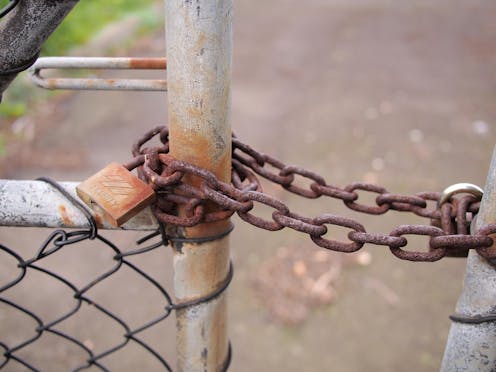Source: The Conversation (Au and NZ) – By Melanie Baak, Senior Lecturer, UniSA Education Futures, University of South Australia

After August 2012, the Australian government introduced “deterrence policies” for asylum seekers who arrive here by boat. Part of this is keeping them on temporary visas and giving them almost no feasible pathway to permanent residency.
Many linger in detention centres, while others who may be in community detention still face constraints on their freedoms. Many live below the poverty line and suffer significant mental health issues. They are also locked out of many education opportunities.
Temporary visas for asylum seekers include:
-
temporary protection visas (TPV), granted for three years. Holders can work, access Medicare and some social security payments
-
safe haven enterprise visas (SHEV). These are granted for five years and require holders to work or study in a part of regional Australia. At the end of five years, SHEV holders may apply for a permanent visa
-
bridging visas (BV). Holders can live in the community but don’t receive housing support and have limited other supports.
One of the possible pathways to transition from a SHEV to a permanent visa is having been enrolled in full-time study in a designated regional area for at least three and a half years. This makes education a crucial pathway to staying in Australia, as well as to employment.
Read more:
Asylum seekers left ‘desperate’ and ‘helpless’ when they try to find work in Australia
Education also provides opportunities to learn and develop English, interact with the broader community and develop skills and qualifications.

Shutterstock
But asylum seekers have no way of paying the international fees required to study at a university, and those still at school can’t stay there after they turn 18. There are no known cases of people successfully meeting the criteria to transition from a SHEV to a permanent visa.
How asylum seeker students are locked out
We are conducting an ongoing study which investigates how schools foster resilience in refugee students.
All children aged under 18 on temporary visas can go to school. But once they turn 18, they can no longer get government-funded schooling, even if they have not finished school.
A school leader told us that once students turned 18
[…] The department would not fund them. If the school wanted to keep them it would be at the school’s cost and we’d have to write a very compelling statement about why they should stay.
This particular school advocated for the around 20 students who were affected, and they were able to stay at the school. But new students aged over 18 were not allowed to enrol.
Read more:
Refugee students struggle with displacement and trauma. Here are 3 ways schools can help them belong
For other schools in our study without the knowledge and ability to advocate, students had to leave high school. Beyond being deprived of the opportunity to finish school, it is even more difficult for students on temporary visas to attend university.
A recent publication by Deakin University contains a case study of Hadi, a student from Afghanistan on a temporary visa. Hadi says:
[…] the fear of not being able to study at university would always keep me up at night. My teachers were also concerned because I was categorised as an international student and I was not eligible for a government funded place at university.
The exact number of students impacted by these preventative policies is not known. But those who gain admission to a university would have to pay around $30-40,000 per year. This is unaffordable for them.
A school finance officer from a school participating in our study said:
[Students on protection visas] come to us for education. We want to do our bit and then they finish with us and they achieve an ATAR that’s got value for a university. And then the university says well we can’t take you unless we treat you like an international student. They just can’t do that.
What universities are doing
Twenty-five Australian universities and one other higher education provider offer scholarships for students on temporary visas. These generally cover the tuition fee and some universities provide a stipend. There are about 15 universities without such scholarships.
Deakin University, for example, provides a Deakin Sanctuary Scholarship to successful applicants holding a TPV, SHEV or relevant BV. This covers 100% of tuition fees and provides recipients with $6,000 per year towards study expenses.
The University of Adelaide provides an annual Refugee and Humanitarian Scholarship to TPV, SHEV or relevant BV holders. This also covers 100% of tuition fees and gives recipients a one-off $2,500 payment.
Scholarship holders at University of Adelaide are restricted in the undergraduate programs they can undertake and cannot pursue degrees such as medicine, dentistry, occupational therapies, as well as double or combined degrees.
A South Australian school principal in our study told us these scholarships weren’t easy to get:
When they get to the end of school you sometimes watch that fall apart a little because their options are very limited beyond school. They can’t afford university. We hear talk of scholarships but trying to navigate that system is almost impossible and unless you’re a 95-plus student you probably won’t get one of those scholarships.
There are success stories from these scholarship programs, such as Farzaneh Dehghani who graduated as a civil engineer from RMIT and subsequently got a job in her field – but the competition for a limited number of scholarships is high.
What needs to be done
Two simple measures would improve this situation.
Governments in other countries offer access to higher education for students on temporary protection or asylum visas. In Scotland, asylum-seeking students under 25 are who have lived there for at least three years are treated as “home” students. This means they access higher education for free.
In Germany, asylum-seeking students have the same rights to access higher education as local students and can apply for exemptions to university fees.
Read more:
How people seeking asylum in Australia access higher education, and the enormous barriers they face
Given the relatively small number of students on temporary visas in Australia and the significant equity benefits of providing scholarships – such as improved settlement outcomes, pathways into employment and opportunities for pathways to permanent visas – all Australian higher education providers should be making such provisions.
Ultimately, Australians can help asylum-seeker students gain access to university by pressuring governments to scrap the punitive and arbitrary visa system which ignores the well-being of young people and dehumanises them for political ends.
![]()
Melanie Baak receives funding from the Australian Research Council (LP170100145), Department of Education (Qld), Department for Education (SA), Catholic Education South Australia.
Bruce Johnson receives funding from the Australian Research Council (LP170100145), Department of Education (Qld), Department for Education (SA), Catholic Education South Australia. He is also a member of the Australian Research Council’s College of Experts.
Joel Windle does not work for, consult, own shares in or receive funding from any company or organisation that would benefit from this article, and has disclosed no relevant affiliations beyond their academic appointment.
– ref. Education is a human right, but for most asylum seekers in Australia, university is an impossible dream – https://theconversation.com/education-is-a-human-right-but-for-most-asylum-seekers-in-australia-university-is-an-impossible-dream-174881







